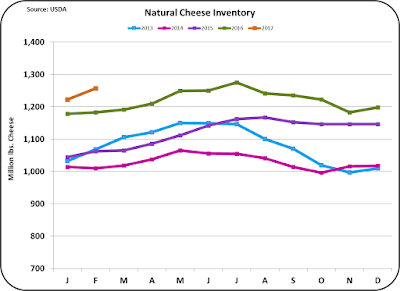March 2017 Class and Component Prices were just released. Other Solids continued making gains with an 11.9% increase. Butterfat prices saw very little change from the prior month, but the drop in cheese prices caused an 18.6% drop in the price of milk protein. Milk protein is now worth $1.82/lb. and butterfat is worth $2.42/lb. The price of Class III milk dropped 6.3% to $15.81/cwt. While $15.81/cwt. is lower than the prior month, it is higher than eight of the months in 2016.
Other Solids, which is priced based on the price of Dry Whey, has increased every month for the last 12 months. It is not yet at the price maintained from 2012 to 2014, but Other Solids has shown very steady growth.
Cheese pricing is the most important parameter behind Class III pricing. Production of cheese is rising faster than the domestic consumption and exports.
As a result, cheese inventories are also growing at a rate that is above the long-term growth rate. Higher inventories bring concerns of over supply and thusly, lower wholesale prices. Exports, while growing, are also not growing fast enough to impact the inventories.
Cheese prices, as shown in the chart below, are at an eight-month low. The futures market for cheese is suggesting price increases through the remainder of 2017, but even with that recovery, cheese prices will be 25% below the 2014 highs. Cheese prices have typically shown increases, however, the current prices are well below earlier trends. No return to 2014 levels is forecast in the next two years.
By contrast, inventories of Dry Whey are low, and with the growth in exports there are no concerns about over-supply. To date, 37% of dry whey has been exported. Exports have grown by 13% over the prior year.
The other route to improved pricing could come from a higher Class IV price. Class I pricing is based on the higher of the Class III or Class IV, and the Class II price is always based on the Class IV price.
However, The Class IV price has been well below the Class III price since the start of 2016. The Class IV price is based on the price of nonfat dry milk, and the international markets determine the price of nonfat dry milk. The U.S. has competed aggressively in international sales of nonfat dry milk. As a result, exports are at record levels. However prices are very low, especially when compared to the 2014 levels.
While price improvement in nonfat dry milk is expected in the long-term, little change is expected in 2017.
CONCLUSION
Based on the above analytics and futures market progressions, producer milk prices can be expected to show only modest recovery in 2017. Much depends on international conditions and exchange rates. The next post to this blog will update export/imports analytics. NAFTA is a wild card in this arena. Mexico and Canada are the two largest importing markets for U.S. dairy products. However, Canada is no longer accepting ultra filtration milk from the U.S., perhaps in violation of NAFTA, and export/import relations with Mexico are cloudy and may be reviewed and revised later this year.
Sunday, April 9, 2017
Subscribe to:
Post Comments (Atom)










No comments:
Post a Comment